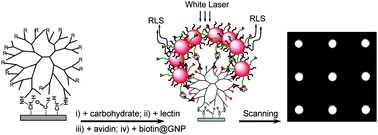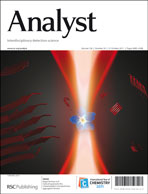Here, a three-dimensional (3D) carbohydrate microarray-based plasmon resonance light scattering (RLS) assay has been established for studying carbohydrate–lectin binding with high selectivity. The 3D carbohydrate microarray is fabricated by immobilizing amino-modified carbohydrates on the home-made fourth-generation (G4) NH2-terminated poly(amidoamine) dendrimers (PAMAM)-modified substrate. After marking the carbohydrate–lectin binding events by 13 nm peptide-stabilized gold nanoparticles through the biotin–avidin reaction, the 3D microarray can be directly detected by the RLS scanner without the conventional silver enhancement step. The well defined recognition systems: three monosaccharides (Man-α, Glc-α and Gal-β) with two lectins (Con A and RCA 120), have been chosen here to establish the RLS assay, respectively. Quantitative determination of the surface dissociation constants (KD,surf) for surface carbohydrates and lectins has been achieved. In addition, inhibition values (i.e. the inhibition constants (Ki) and the concentrations of inhibitors required to produce 50% inhibition (IC50)) for inhibitors in solution are also demonstrated by the saccharide competing assays.

You have access to this article
 Please wait while we load your content...
Something went wrong. Try again?
Please wait while we load your content...
Something went wrong. Try again?


 Please wait while we load your content...
Please wait while we load your content...